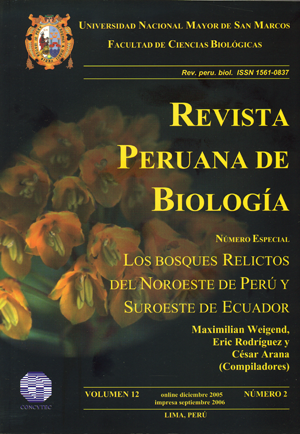Spatial distribution patterns of trees in a seasonally dry forest in the Cerros de Amotape National Park, northwestern Peru
DOI:
https://doi.org/10.15381/rpb.v12i2.2405Keywords:
dispersal, dry forests, regeneration, Ripley’s K, Peru, Cerros de Amotape National ParkAbstract
A study to reveal spatial distribution patterns in four characteristic dry forest tree species was undertaken in six one-hectare plots in the Cerros de Amotape National Park, northwestern Peru. The modified Ripley’s K statistic was used. Eriotheca ruizii (K. Schum.) A. Robyns (Bombacaceae), Bursera graveolens (Kunth) Triana & Planch. (Burseraceae), Caesalpinia glabrata Kunth (Leguminosae) and Cochlospermum vitifolium (Willd.) Spreng. (Cochlospermaceae) present in 11 out of 17 cases, patterns that are not significantly different from a completely random pattern. At the analysed spatial scale, this disagrees with the widely held notion that tropical tree species present clumped patterns. The different factors that may contribute to the observed patterns are discussed.Downloads
Downloads
Published
Issue
Section
License
Copyright (c) 2005 Reynaldo Linares-Palomino

This work is licensed under a Creative Commons Attribution-NonCommercial-ShareAlike 4.0 International License.
AUTHORS RETAIN THEIR RIGHTS:
a. Authors retain their trade mark rights and patent, and also on any process or procedure described in the article.
b. Authors retain their right to share, copy, distribute, perform and publicly communicate their article (eg, to place their article in an institutional repository or publish it in a book), with an acknowledgment of its initial publication in the Revista Peruana de Biologia.
c. Authors retain theirs right to make a subsequent publication of their work, to use the article or any part thereof (eg a compilation of his papers, lecture notes, thesis, or a book), always indicating its initial publication in the Revista Peruana de Biologia (the originator of the work, journal, volume, number and date).






